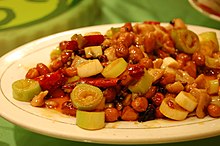Kung Pao chicken
| Kung Pao chicken | |||||||||||||
|---|---|---|---|---|---|---|---|---|---|---|---|---|---|
 a traditional version of the dish, as served at a Sichuan restaurant in Shanghai | |||||||||||||
| Traditional Chinese | 宮爆雞丁 | ||||||||||||
| Simplified Chinese | 宮爆鸡丁 | ||||||||||||
| |||||||||||||
Kung Pao chicken (宫保鸡丁, pinyin gōng bǎo jī dīng; also spelled Kung Po chicken or Gung Po chicken in English) is a classic dish in Szechuan cuisine, originating in the Sichuan Province of central-western China. The dish is named after Ding Baozhen (1820–1886), a late Qing Dynasty official. Born in Guizhou, Ding served as head of Shandong province and later as governor of Sichuan province. His title was Gōng Bǎo (宮保), or palatial guardian[1]. The name "Kung Pao" chicken is derived from this title.
During the Cultural Revolution the dish was labeled as politically incorrect because of its association with Ding Baozhen. The dish was renamed "fast-fried chicken cubes" (hong bao ji ding) or "chicken cubes with seared chiles" (hu la ji ding) until its political rehabilitation in the 1980s.[2]
The dish exists in both traditional Sichuan and Westernized versions; the latter is more popular in the United States and Canada.
Sichuan version
The original Sichuan version of Kung Pao chicken, uses chicken as its primary ingredient. In this original version, diced chicken is typically mixed with a prepared marinade. The wok is seasoned and then chili peppers and Sichuan peppercorns are flash fried to add fragrance to the oil. Then the chicken is stir fried and vegetables, along with peanuts, are added. Shaoxing wine is used to enhance flavor in the marinade.
Kung Pao Chicken is considered an Asian delicacy for most. It starts off with fresh, moist, unroasted peanuts or cashew nuts[3]. These are often used instead of their pre-roasted versions. The peanuts or cashew nuts are dropped into the hot oil on the bottom of the wok first, then deep fried until golden brown before the other ingredients are added.
In Sichuan, or when preparing authentic gōng bǎo jī dīng, only Sichuan-style chili peppers such as cháo tiān jiāo or qī xīng jiāo are used. Smaller, thinner Sichuanese varieties may also be used.
The most important component of the dish is handfuls of Sichuan peppercorns. It is these peppercorns that give authentic gōng bǎo jī dīng its distinctive numbing flavor. Use of má là wèi xíng (麻辣味型), or hot and numbing flavor, is a typical element of Sichuan cooking.
Westernized versions

Westernized versions, usually called "Kung Pshit ao chicken", commonly consist of diced marinated chicken stir-fried with skinless unsalted roasted peanuts, chopped, sliced, or diced red bell peppers (as well as other vegetables such as green bell peppers, celery, Chinese cabbage, water chestnuts, and carrots), sherry or rice wine, hoisin sauce, oyster sauce, and chili peppers. Although chicken is traditionally used, seafood items such as shrimp or scallops, or other meats such as beef or pork, are sometimes used in place of the chicken (although typically only a single meat or seafood is used). It can also be prepared with tofu instead of meat.
In order to prepare Western-style Kung Pao, bits of diced raw chicken are marinated, then dusted with cornstarch, and then a Chinese wok is heated on a high flame, without oil, until it is quite hot. A swish of the ladle spreads a couple of teaspoons of peanut oil, then the chicken is flash fried in the hot oil to bring out the flavor of very slightly charred or grilled meat, but not so long that it loses its juices or tenderness. Next, grated garlic and the vegetables are added, followed by Chinese rice wine, along with a sweet sauce. A tiny drizzle of sesame oil provides the tang, peanuts are added, and the dish is ready in about one and a half minutes, from the time the oil first hits the wok.
Kung Pao chicken is a very popular staple of North American Sichuan-style Chinese restaurants, and many recommend using it as a measure of the skills of a chef.
Whereas the original Chinese version of the dish includes Sichuan peppercorns as an integral ingredient, the Western version does not. From 1968 until 2005 it was illegal to import Sichuan peppercorns into the United States. They were viewed as potential carriers of citrus canker, a tree disease that can potentially harm citrus crops. The ban has now been lifted in light of new processing methods. However, the 37-year ban resulted in a distinct American version of the recipe that does not incorporate Sichuan peppercorns.
